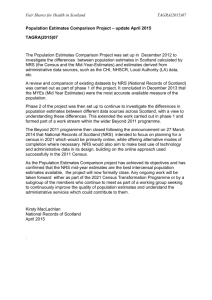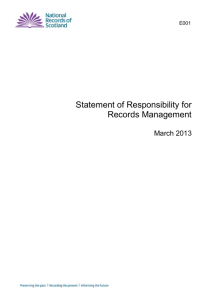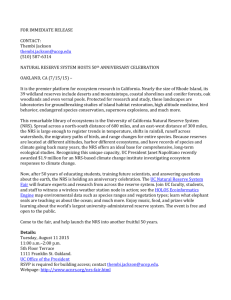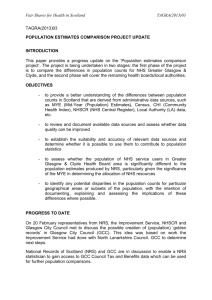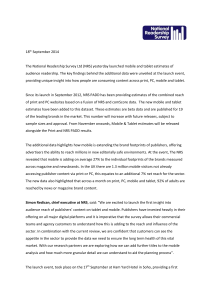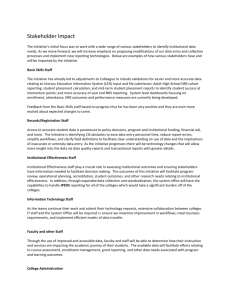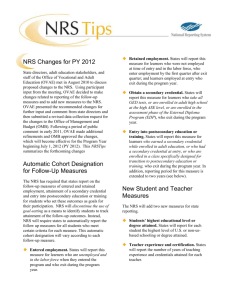NRS 004 RMCP End of Stage 4 Progress Report, word file, 66KB
advertisement
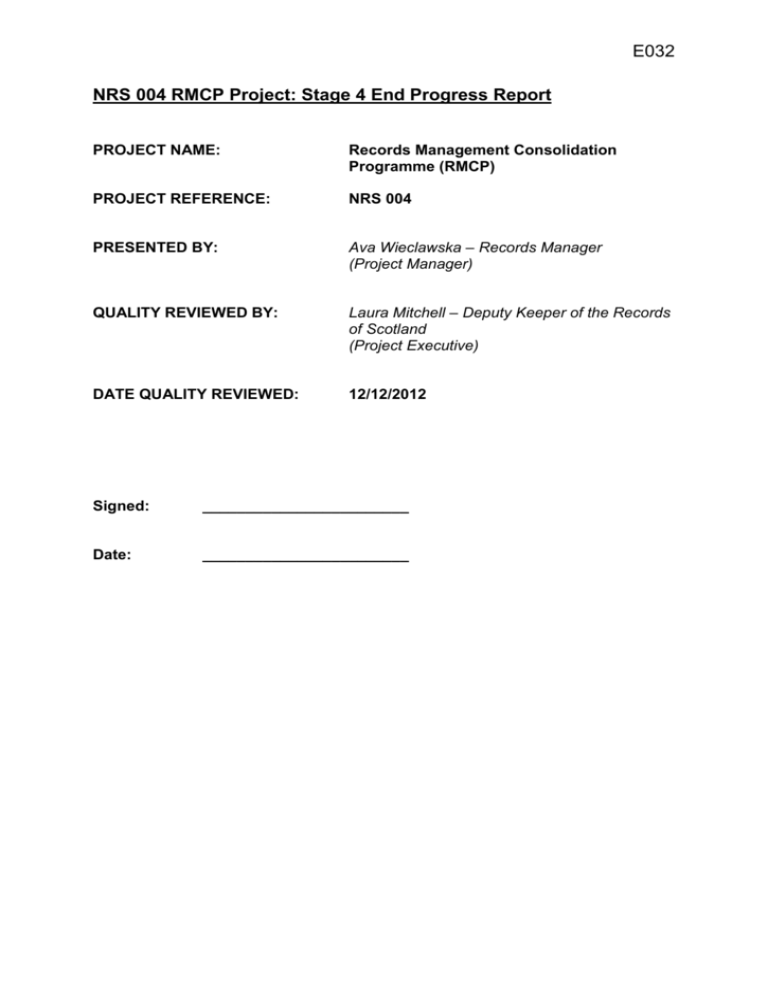
E032 NRS 004 RMCP Project: Stage 4 End Progress Report PROJECT NAME: Records Management Consolidation Programme (RMCP) PROJECT REFERENCE: NRS 004 PRESENTED BY: Ava Wieclawska – Records Manager (Project Manager) QUALITY REVIEWED BY: Laura Mitchell – Deputy Keeper of the Records of Scotland (Project Executive) DATE QUALITY REVIEWED: 12/12/2012 Signed: ________________________ Date: ________________________ 1. Executive Summary 1.1 The Records Management Consolidation Programme (RMCP) has now reached the end of Stage 4: Design and Implementation. The key project outputs delivered during Stage 4 include a Records Management Policy; a draft Business Classification Scheme and mapped Retention and Disposal Schedule; an Information Asset Register; a Data Protection Policy and two supporting Codes of Practice; a Managing E-Records Framework (including Document Naming Guidelines, Abbreviations and Acronyms, and Managing Email Policy); a Statement of Responsibility; Competency Framework; Records Management Unit Manual; this End of Stage Progress Report and an e-Newsletter which will be circulated to all staff following approval at the Stage 4 End Project Board meeting on 12 December 2012. 1.2 Stage 4 has also delivered a draft Records Management Plan, as required under the Public Records (Scotland) Act 2011. It is expected that this Plan will be submitted to the Keeper of the Records of Scotland for approval, in early 2013. 1.3 The primary aim of Stage 4 was to consolidate existing, and establish new, recordkeeping policies, procedures and systems across the organisation in order to meet the requirements identified in Stage 2, incorporate them into a comprehensive Records Management Plan and implement them across the organisation as a whole. 1.4 A number of project outputs from Stage 4 remain outstanding and require completion prior to approval. It is expected that these outputs will be completed and ready for sign off by the end of January 2013. They include a Corporate Training Plan for all NRS staff, a Business Impact Analysis, Business Continuity Plan, and 3 year Records Management Strategy. Discussions will be held with cross-divisional stakeholders in January 2013, regarding the future of electronic records management within NRS. These discussions will inform the key decisions which are to be made in relation to Element 11: Audit Trail of the Records Management Plan. 1.5 Stage 5: Training & Awareness will commence once the outstanding project outputs have been completed and Stage 4 has been signed off by the Project Board. 2. Stage 4 Project Outputs 2.1 A Statement of Responsibility, outlining the roles and responsibilities of the Senior Manager and Records Manager for NRS, has been drafted. It is awaiting approval by the Project Board. This statement meets the requirements of Elements 1 and 2 of the Records Management Plan (RMP). 2.2 A Records Management Policy, defining the roles and responsibilities and commitment to recordkeeping within NRS, was produced, reviewed and signed off by the Department Planning Group (now Senior Management Team) on 12 September 2012. The Policy is available on both the National Archives of Scotland and General Register Office for Scotland websites. It is also available on theOracle and Quickr. The production of this policy meets the requirements of Element 3 of the RMP. 2.3 A functional based, draft Business Classification Scheme (BCS) was produced in cooperation with all branches. The BCS was sent to Archives New Zealand and the Health and Safety Executive for peer review in mid-September. Both organisations have now completed their review and have suggested some minor recommendations for amendment. Please refer to item 3.2 for further details. The completed BCS will act as evidence of compliance with Element 4 of the RMP. 2.4 A comprehensive Retention and Disposal Schedule outlining the key record types produced by NRS as well as their recommended minimum retention periods and disposal procedure has been produced in line with the functional structure of the BCS. The schedule also details the vital records of the organisation. Once the schedule has been signed off, it will act as evidence of compliance with Element 5 of the RMP. 2.5 A Disposal of Official Information Policy is in existence within NRS and can act as evidence in relation to Element 6 of the RMP. However, a number of issues have been raised in relation to this policy and so it is currently under review. 2.6 A statement of process has been produced by Government Records Branch in relation to Element 7: Archiving and Transfer Arrangements. The arrangements, however, are still outstanding. It is expected that some or all of these new arrangements will be produced and made available for inclusion in the RMP, in January 2013. 2.7 A number of information security policies and procedures are in operation within NRS. They have been circulated for review and a number of comments have been raised in relation to these. The Head of Information Security and Assurance is currently reviewing these comments with a view to making a number of amendments prior to submission of evidence in relation to Element 8 of the RMP. 2.8 A Data Protection Policy has been produced for NRS as well as two supporting Codes of Practice for archival collections and business information. Once approved, these procedures will be published, made available throughout NRS and submitted as evidence in relation to Element 9 of the RMP. 2.9 Progress on the development of procedures for business continuity within the organisation has continued, with the appointment of a Project Manager to oversee these developments over the coming months. A Business Impact Analysis is due to be carried out on 13 December 2012 and branches within the former NAS part of the organisation will look to assess their critical business functions in the New Year. A Business Continuity Plan will also be established. 2.10 A Managing E-Records Framework (including Document Naming Guidelines, Abbreviations and Acronyms and Managing Email Policy) has been produced to support NRS in achieving compliance with Element 11: Audit Trail. A Steering Group has also been identified and will hold an initial meeting on 10 January 2013. Its main purpose is to begin discussing the options for managing electronic records within the organisation and the requirements for an electronic document and records management system. The outcomes of these discussions will inform the evidence to be submitted in relation to Element 11, alongside the E-Records Framework. 2.11 A Competency Framework has been developed in line with the requirements of Element 12 of the RMP. It is to be approved by the Project Board. 2.12 A 3 Year Records Management Strategy will be produced and appended to the RMP in order to demonstrate NRS’s commitment to long-term recordkeeping best practice and outline the framework for review and assessment. 2.13 A statement of compliance with Element 14: Information Sharing of the RMP has been produced and is to be signed off by the Project Board. A draft Data Access Agreement will also be provided in support of this statement. 3. Stage 4 Proposals 3.1 It is recommended that the Project Board approve the following project outputs, so that they may be published and rolled out across NRS: Statement of Responsibility Data Protection Policy Data Protection Code of Practice – Archival Information Data Protection Code of Practice – Business Information Abbreviations and Acronyms Records Management Unit Manual Competency Framework 3.2 A number of key recommendations have been made by Archives New Zealand and the Health and Safety Executive regarding NRS’s first draft BCS. The Project Board should review these recommendations with a view to either: a) Making minor changes to the BCS prior to approval; b) Approving the BCS with a view to reviewing the structure after submission to the Keeper. The recommendations are as follows: i) ii) iii) iv) v) vi) vii) 3.3 Expand the number of top level headings by promoting some of the Level 2 Activities (e.g. Human Resources, Finance, Information Management). Create a Level 1: Strategic Management heading. Rethink classifications such as 'statistics' and 'registration', which seem to be large catch-all terms covering a wide range of activities. The records of these activities could perhaps be better located in the folder for the specific function/activity which led directly to their creation. Place strict limits on 'record types', otherwise it may become unmanageable to deal with them all, and difficult to train staff in their correct use. Fully expand acronyms where possible. Create a folder for website management. Rename the Retention and Disposal Schedule, the Disposal Schedule. It is recommended that the Project Board resolve the following outstanding issues so that the project outputs may be approved: OUTPUT ISSUE(S) Retention and Disposal Schedule Vital records to be reviewed and approved Document Naming Guidelines Statistical branches unable to apply rules to datasets; Use of underscores in titles; <Surname><Forename> or vice versa; Use of General in document names Use of PST files Procedures for sending sensitive/confidential information via non-GSI accounts Information Security Policies (including Information Security Policy Statement, Disposal of Official Information Policy, Forensic Readiness Policy and Plan, Risk Analysis and Management Policy, Security Incident Reporting Procedure, Data Handling and Management Guidelines) Timescales for reviewing and amending each policy/procedure Managing Email Policy 3.5 It is recommended that the Project Board extend the deadline for the completed project outputs of Stage 4 to 31st January 2013, in order to allow for further developments in the Business Continuity Programme, discussions to be held in relation to the strategy for managing electronic records, and further investigations into the most effective training options. A Project Board meeting should then be held during the first week of February in order to approve the Records Management Plan, prior to the commencement of Stage 5: Training and Awareness. 3.6 It is also recommended that the Project Board seek to produce a Covering Statement in support of the Records Management Plan.
